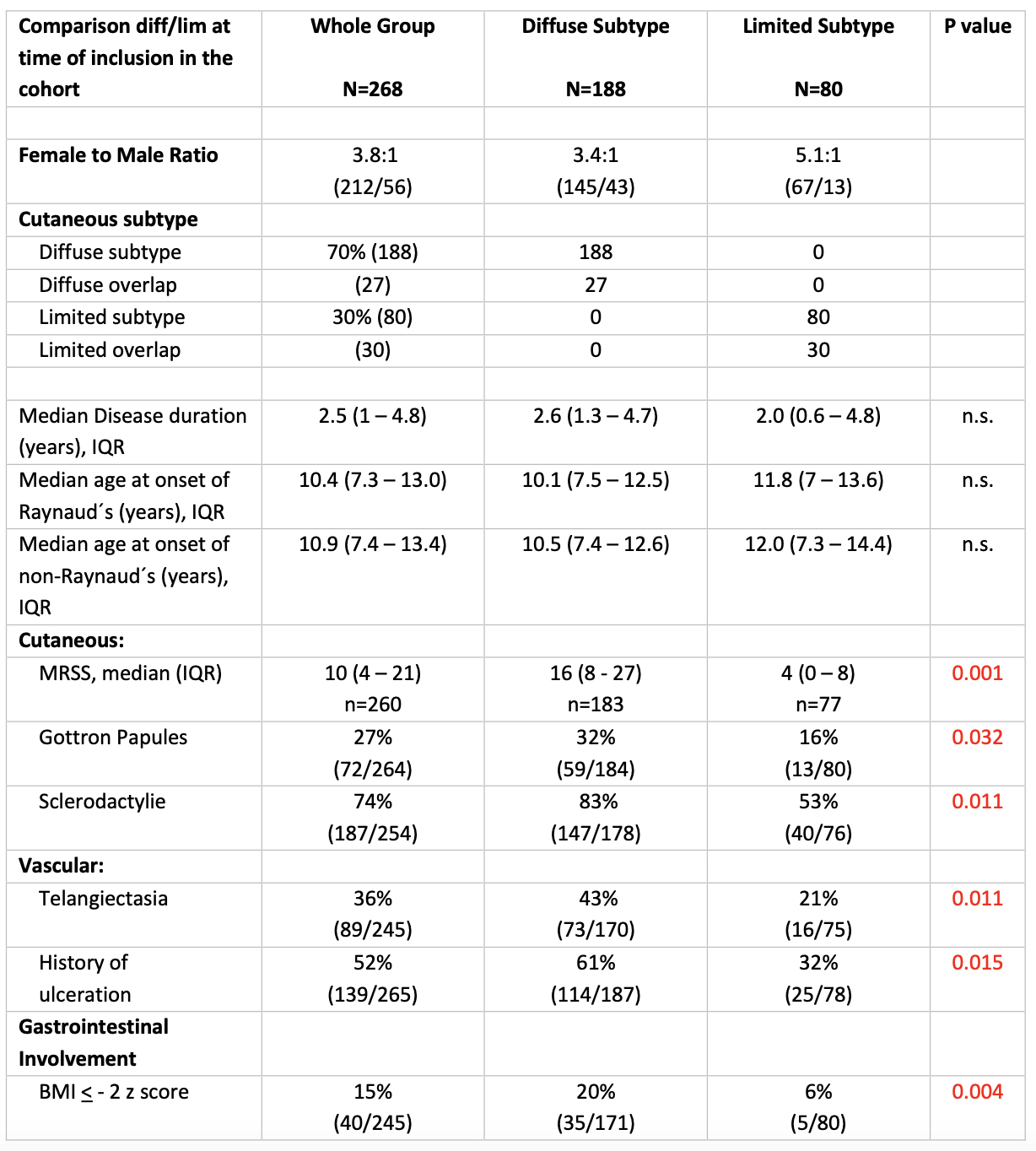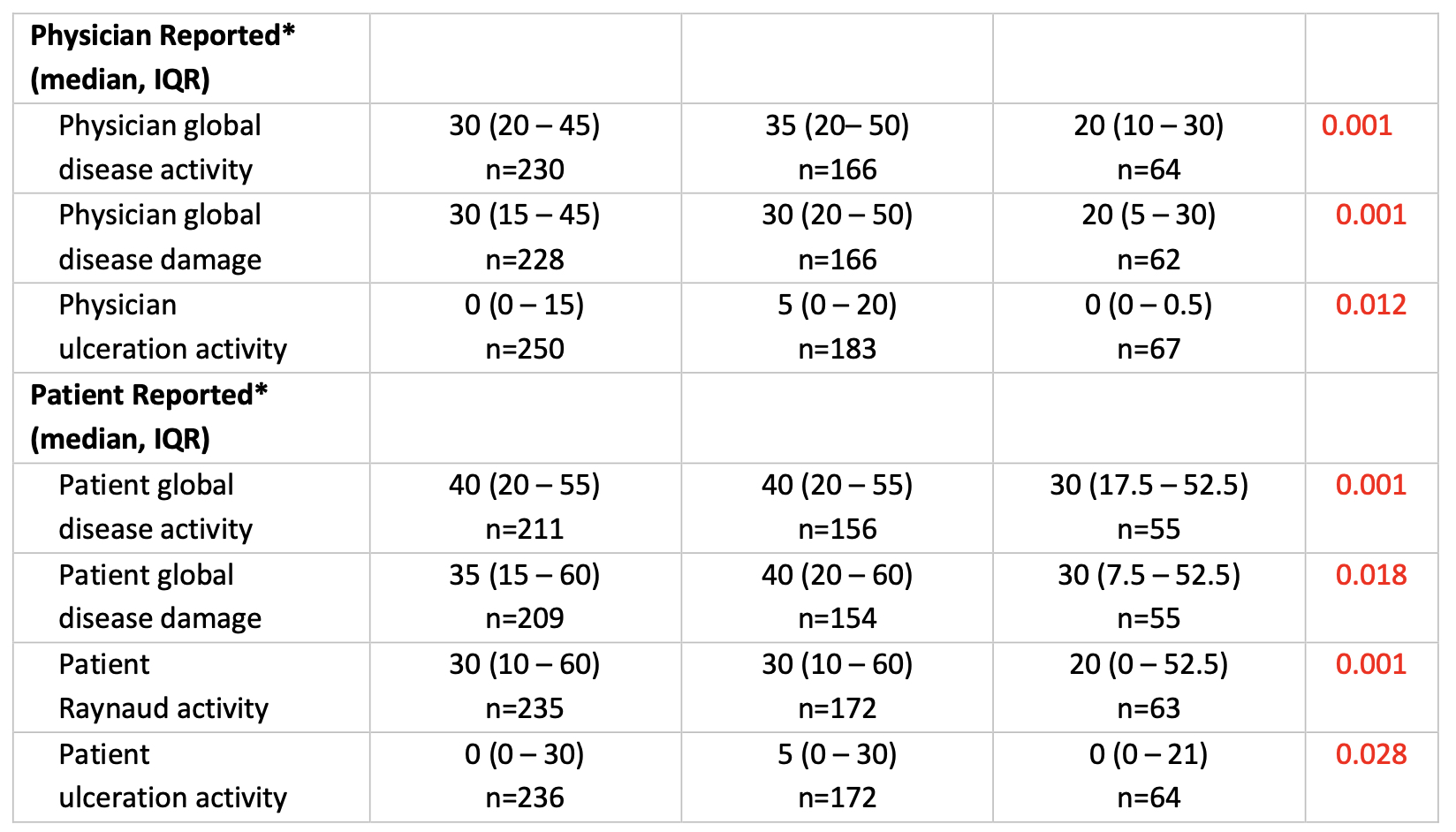Session Information
Session Type: Poster Session C
Session Time: 10:30AM-12:30PM
Background/Purpose: In adult systemic sclerosis they are significant differences in clinical presentation of diffuse and limited subtype. In juvenile systemic sclerosis (jSSc) are the differences less prominent as we reviewed last time in a publication for the first 150 patients [1] of the juvenile scleroderma inception cohort(jSScC). The differences are changing as the included number of patients is growing in the cohort.
Methods: We extracted date from the jSScC including patients who were enrolled till 1st April 2024 into the cohort [1]. We compared the clinical characteristics, PRO and PhRO of the two subtypes and calculated statistical significance using chi-square test.
Results: 268 patients were included in the study. 70% (n=188) of the patients had diffuse subtype. Around 70% of the patients were Caucasian in both groups. The median age of onset of Raynaud´s were 10.1 in the djSSc and 11.8 years in the ljSSc. The median age at the time of the first non-Raynaud was 10.1 years in the djSSc and 11.8 years in the ljSSc. Looking at antibody we could not show any significant differences. (Table 1.) Modified Rodnan skin score (16 versus 4, p=0.001), more frequently Gottron papules (32% versus 16%, p=0.032), with sclerodactyly (83% versus 53%, p < 0.001), with telangiectasia (43% versus 21%, p=0.011), with history of ulceration (61% versus 32%, p< 0.015)), with decreased Body mass Index <2 standard deviation (20% versus 6%, p=0.004). None of the patients had renal crisis. There was no significant difference in cardiopulmonary, gastrointestinal involvement and musculoskeletal involvement. Looking at PRO and PhRO in all categories djSSc patients had significantly more severe disease (Table 2.).
Conclusion: These results present a different organ involvement pattern form adult patients. Despite more severe disease according to patient and physician reported outcomes, we found no significant differences in the cardiopulmonary, renal, gastrointestinal involvement and musculoskeletal organ involvement between the subtypes. The antibody profile anti-Scl70, anti-centromere and anti-PMscl was not different between subtypes either. It seems to be that for pediatric patients the subsetting into diffuse and limited does not make so much difference.
[1] Foeldvari I, Klotsche J, Kasapcopur O, et al. Differences Sustained Between Diffuse and Limited Forms of Juvenile Systemic Sclerosis in an Expanded International Cohort. Arthritis Care Res (Hoboken). 2022 Oct;74(10):1575-1584.
To cite this abstract in AMA style:
Foeldvari I, Klotsche J, Torok K, Kasapcopur O, Adrovic A, Feldman B, Sztajnbok F, Anton J, Johnson S, Terreri M, Sakamoto A, Khubchandani R, Stanevica V, Özomay Baykal G, Schonenberg-Meinema D, Al-Abadi E, Alexeeva E, Katsicas M, Sawhney S, smith v, Appenzeller S, Avcin T, Kostik M, Lehman T, Li S, Malcova H, marrani e, Pain C, Patwardhan A, Sifuentes-Giraldo W, Vasquez-Canizares N, Abu Alsaoud S, Costa Reis P, Hajek, Stefanie H, Janarthanan M, Nemcova D, Opsahl Hetlevik S, Santos M, Battagliotti C, Berntson L, bica b, Brunner J, Harel L, Horneff G, Kaiser D, Lazarevic D, Nuruzzaman F, Sparchez M, Helmus N. There Is No Difference in Major Organ Involvement Andantibody Pattern Between Diffuse and Limited Subtypejuvenile Onsetsystemic Scleroderma Patients [abstract]. Arthritis Rheumatol. 2024; 76 (suppl 9). https://acrabstracts.org/abstract/there-is-no-difference-in-major-organ-involvement-andantibody-pattern-between-diffuse-and-limited-subtypejuvenile-onsetsystemic-scleroderma-patients/. Accessed .« Back to ACR Convergence 2024
ACR Meeting Abstracts - https://acrabstracts.org/abstract/there-is-no-difference-in-major-organ-involvement-andantibody-pattern-between-diffuse-and-limited-subtypejuvenile-onsetsystemic-scleroderma-patients/


